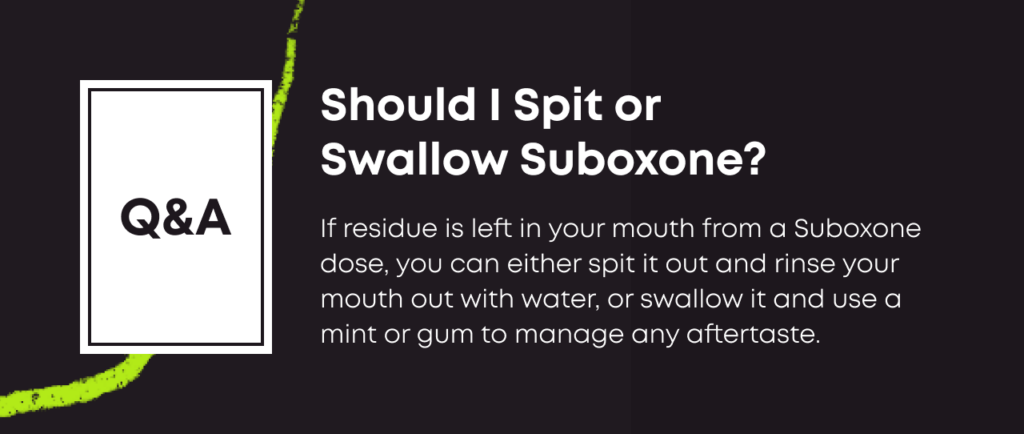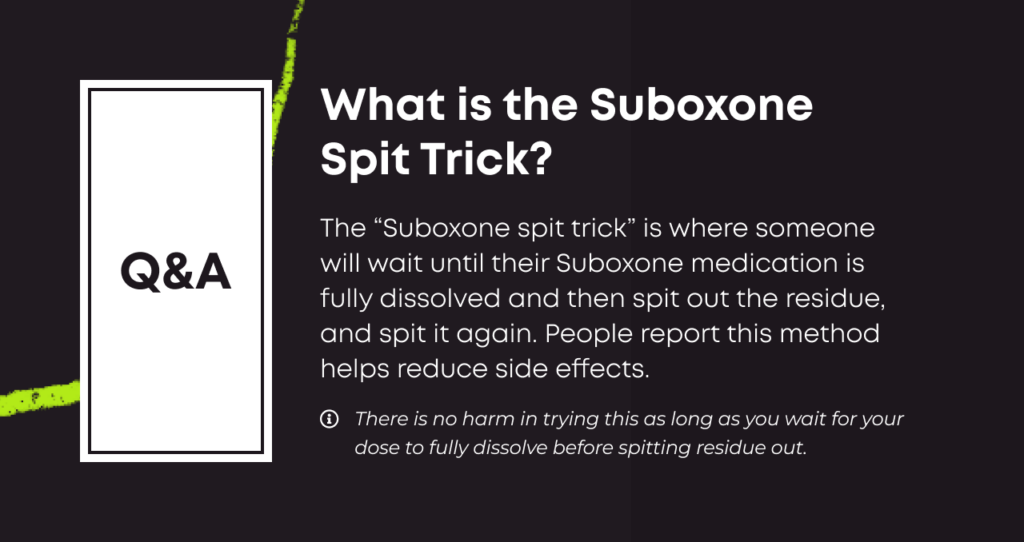Suboxone comes in two dissolving formulations: tablets and films. Both are dissolved under the tongue or cheek (“sublingually”). This usually takes anywhere from 1-10 minutes. Afterward, people may notice a small amount of residue under the tongue which can have an unpleasant flavor or consistency. First-time Suboxone users sometimes worry about spitting or swallowing this residue, but either one is safe. Some people prefer the “Suboxone spit trick” of spitting out the residue, which may help reduce the aftertaste. People also self-report that the Suboxone spit trick helps decrease the risk of side effects like migraines and constipation.

How Should I Take Suboxone?
Suboxone is the brand name combination of buprenorphine (a partial opioid agonist) and naloxone (an opioid antagonist that minimizes the risk of overdose).[2]
Buprenorphine controls drug cravings and can help you avoid withdrawal symptoms that could trigger a relapse. This medication is powerful but can be a little tricky to get the hang of how to take it.
If you have been prescribed Suboxone as a Medication for Addiction Treatment (MAT), it is essential to take it as directed.
Your physician will provide you with specific advice, but in general, follow these steps per the product you’re provided:[1]
- Tablets: Place them under your tongue until they melt completely.
- Buccal/sublingual films: Wet the inside of your cheek or rinse. Then, apply the film with dry fingers to the inside of your cheek or place it under your tongue.
When the medication is in place, hold your mouth firmly closed and wait for the medication to dissolve—usually anywhere from 1 to 10 minutes. Try not to move the dose around in your mouth and avoid talking or eating. Don’t chew or suck on the tablet or strip as this can negatively affect absorption and efficacy.
Spitting vs. Swallowing Residue: Which Is Safest?
People taking Suboxone should let their doses melt completely before eating drinking water, or otherwise opening their mouths.[1] If you take your Suboxone dose properly, you shouldn’t have much residue left over. However, the naloxone component of Suboxone is not dissolved in the mouth, and so some people notice a little bit of residue even once the strip is fully dissolved. This residue can have a bitter taste.
If you do have residue, you can either spit out the residue—known as the Suboxone spit trick—or swallow it with a sip of water. The choice is up to you—both are safe. Some people don’t like the taste of the residue or they feel it bothers their stomach in which case they prefer to spit it out. Others don’t mind swallowing it.

What Is the Suboxone Spit Trick?
In the so-called “Suboxone spit trick,” people using Suboxone will wait until their medication is fully dissolved and then spit out the residue, rinse, and spit again.
If your mouth feels sticky, chalky, or dry after using your medication, this could be a good option for you. Likewise, if you dislike the aftertaste, this could help minimize it. Just make sure you wait until your medication is fully dissolved, which can be up to 10 minutes for some people.
Does the Suboxone Spit Trick Work?
People who take Suboxone and use the spit trick report that it helps reduce side effects, such as:
- Migraines
- Constipation
- Mood swings
- Low blood pressure
As long as you wait for your Suboxone to fully dissolve before spitting out the residue, there is no harm in trying this strategy to see how it works for you.
What About Swallowing the Suboxone Residue?
People following the FDA’s recommendation swish water around in their mouths and swallow the residue after their doses have completely dissolved.[4]
This method won’t get you high or make you sick. And it could help with any chalky taste too.
Does Suboxone Impact Your Oral Health?
Buprenorphine products can be hard on your oral health, causing low saliva levels/dry mouth in the short term and potentially tooth decay in the long term (usually over the course of years).
The U.S. Food and Drug Administration recommends the following to help protect your oral health long-term: [4]
- Wait until the product is completely dissolved and then rinse the mouth with water or swipe some water after taking your dose.
- Brush your teeth about an hour after taking your dose.
- Make sure you are brushing and flossing regularly.
- Make sure you are receiving regular care from a dentist.
Suboxone’s Bioavailability
Unlike most pills which absorb well through the stomach lining, only about 10% of an oral dose of Suboxone gets absorbed through the stomach, but up to 55% is absorbed through oral membranes.[3]
For this reason, it comes in a tablet/strip to be dissolved in the mouth so that it becomes more “bioavailable” (more of it is actually absorbed and can act in the body).
What Not to Do With Your Dose
You should avoid the following:
- Tampering with your dose: Do not tear, cut, chew, swallow, touch, move, or otherwise tamper with the film.
- Misusing your medication: If you feel tempted to misuse your dose and take it in a way other than prescribed, you are at risk of relapse and should speak to your physician, counselor, or rehab program.
- Taking other substances without talking to your team: Opioids, alcohol, and benzodiazepines could cause oversedation. Discuss their use with your physician before you take these medications with your Suboxone.
- Adding too much to your mouth before and after your dose: A rinse with water is recommended. But do not eat, drink, or smoke cigarettes for 15 minutes before and 15 minutes after taking Suboxone.
What Happens When I Swallow Suboxone?
Suboxone doesn’t absorb well through the stomach. It may cause you to feel some nausea or upset stomach if the dose is accidentally swallowed. Most importantly, you will likely not get adequate relief from the medication if the dose is swallowed, meaning you may still experience opioid withdrawal symptoms or opioid cravings.
While oral bioavailability is low, it’s not zero. If children or pets who have never used buprenorphine swallow your Suboxone, they could get very sick. [5] If there has been accidental ingestion of your Suboxone, go to the emergency room immediately.
Keep your medications in a safe, secure location locked away from others inside your home.

Reviewed By Peter Manza, PhD
Peter Manza, PhD received his BA in Psychology and Biology from the University of Rochester and his PhD in Integrative Neuroscience at Stony Brook University. He is currently working as a research scientist in Washington, DC. His research focuses on the role ... Read More
- Buprenorphine Sublingual and Buccal (Opioid Dependence). U.S. National Library of Medicine. https://medlineplus.gov/druginfo/meds/a605002.html#how. January 2022. Accessed December 2022.
- Suboxone. European Medicines Agency. https://www.ema.europa.eu/en/medicines/human/EPAR/suboxone. July 2020. Accessed December 2022.
- Buprenorphine with Naloxone (Suboxone Sublingual Film) for Opiate Dependence. NPS Medicinewise. https://www.nps.org.au/radar/articles/buprenorphine-with-naloxone-suboxone-sublingual-film-for-opiate-dependence. September 2011. Accessed December 2022.
- Buprenorphine: Drug Safety Communication. FDA Warns About Dental Problems with Buprenorphine Medicines Dissolved in the Mouth to Treat Opioid Use Disorder and Pain. U.S. Food and Drug Administration. https://www.fda.gov/safety/medical-product-safety-information/buprenorphine-drug-safety-communication-fda-warns-about-dental-problems-buprenorphine-medicines. January 2022. Accessed December 2022.
- Buprenorphine: Dangerous to Children. National Capital Poison Control Center. https://www.poison.org/articles/buprenorphine. Accessed December 2022.
Download Our Free Program Guide
Learn about our program, its effectiveness and what to expect
Related Content
Imagine what’s possible on the other side of opioid use disorder.
Our science-backed approach boasts 95% of patients reporting no withdrawal symptoms at 7 days. We can help you achieve easier days and a happier future.